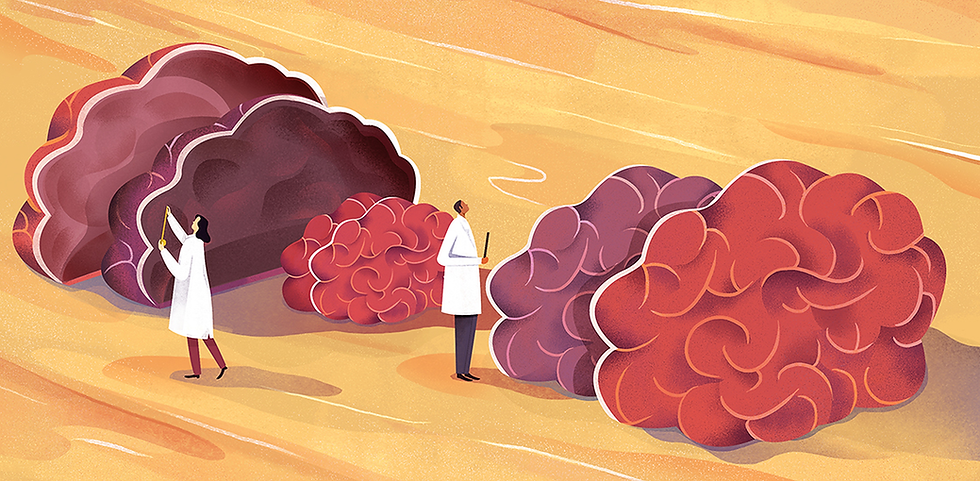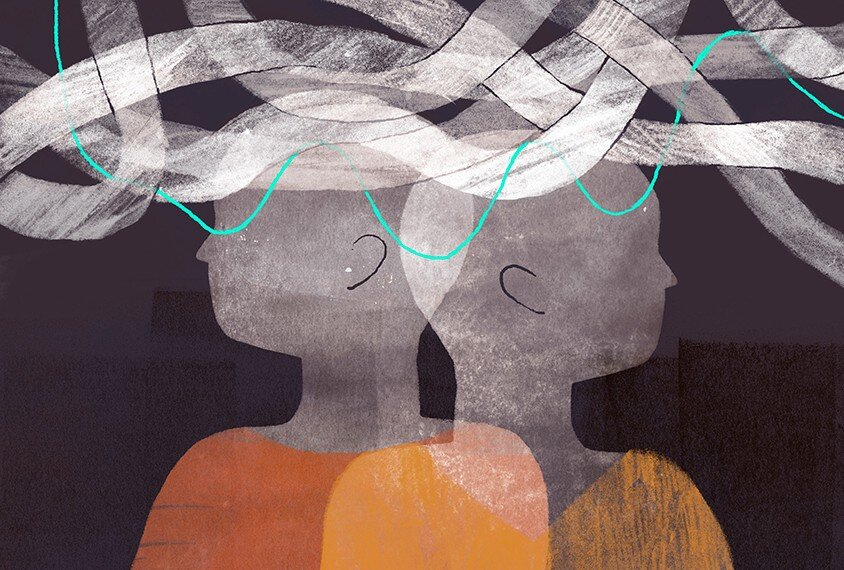The Future of Antipsychotics
- Melisa Kose

- Sep 8, 2021
- 7 min read
Updated: Nov 30, 2023
What Can We Learn from Blood & the Brain?
Since their introduction to medicine in the 1950s, antipsychotics have been the first line of treatment for people struggling with psychosis. Of course, their utility for so many is undeniable, and yet, it’s equally difficult to ignore that a great number of people with psychosis don’t find such treatments helpful to them at all.
Naturally, the first question we ask ourselves here is: well, why not? Why don’t all people with psychotic disorders find improvement on the medicines made specifically for them?
That’s a great question — and one that researchers have spent years searching for the answers for. And what exactly has all this research found so far?
This is exactly what I wanted to understand and so, we decided to conduct a review of all the research on this topic to date.
Alongside my role for InSPIre the Mind, I’m also a research assistant the SPI Lab at King’s College London and, though I have written about inflammation research from our group before (in the context of depression), with this blog, I’ll be discussing the findings of my own review on inflammation and psychosis, and what we can learn from the brain and from the blood.
Before I get too ahead of myself, let me first set the scene:
What is Psychosis & Psychotic Disorder?
Psychotic disorders are mental health conditions that cause atypical thinking and behaviour. For example, someone experiencing a psychotic episode may hear things that aren’t actually there — hallucinations — or believe things that aren’t necessarily based in reality — delusions. Though the severity of these hallucinations and delusions, as well as other behavioural changes like difficulties with emotional balance and trouble with sleep, will vary between people, most people will experience some degree of disruption to their usual behaviour.
As you can expect, people living with something like schizophrenia without effective management can struggle daily with things such as decision-making, concentration, emotional regulation, and other psychiatric disorders such as depression and anxiety, for example.
Though talk therapies are also used, antipsychotic medications are the first-line treatments for psychotic disorders and so finding the best way to predict which patients will and which won’t respond to antipsychotic treatment is essential so that the necessary adjustments to healthcare plans can be made. This way, we can eventually ensure that all individuals with psychosis are getting the most effective treatment possible.
Though we do still have some way to go, researchers have identified a promising avenue: inflammation.
The Role of the Immune System in Psychosis
In the last few decades, there’s been ever-growing interest into how the immune system plays a role in disorders such as ADHD and depression; indeed, depression alone has been a huge area of curiosity; how the immune system interacts with our genes and environment, its interplay with sex hormones, how we can target inflammation as a treatment strategy, and the potential efficacy of anti-inflammatory drugs in depression.
Inflammation is the biological process by which your immune system responds to injury or infection (such as bacteria or viruses). This is a typical and perfectly natural response by your body and, more often than not, it’s a temporary one. However, there are instances where the body’s immune system kicks off this inflammatory response despite the lack of any external threat or injury. We see this quite often in disorders such as depression and ADHD, among others, as discussed regularly on InSPIre the Mind.
The main inflammatory markers studied in patients with psychotic disorders include C-reactive protein (CRP) and cytokines analysed from blood samples.
CRP plays a role in innate immunity as an early defence system against infections and its levels increase following the body coming into contact with infective agents or internal damage leading to immune activation. Cytokines are small proteins produced by immune cells (e.g., macrophages, lymphocytes, mast cells) and represent important signalling molecules for the regulation of the immune response.
What’s interesting in the context of psychosis, is that despite being otherwise healthy (i.e., no flu, no cold, no infection nor physical injury) people with schizophrenia appear to show increased levels of inflammation compared to their no-psychosis-experiencing counterparts.
What does this mean for patients with schizophrenia, though?
As we similarly see in depression, research has shown that atypical levels of inflammation can potentially affect brain structure by disturbing neurogenesis (forming new brain cells), neuroplasticity (the brain's natural ability to adapt), and the functioning of neurotransmitters (chemical messengers of the brain). From this, it has been suggested that the brain changes seen in schizophrenia may be in some way interacting with the inflammatory response to contribute to the development of psychosis and treatment resistance in patients with psychosis.
Where to Next?
So, we decided to conduct what is known as a systematic review — essentially a very thorough search of all existing research on the specific topic we want to learn more about. With this, key literature is selected, in accordance with previously specified criteria, and studied as a collection. This way, we’re able to identify the patterns, similarities, and differences between all the research in a given topic are to then draw conclusions.
Through our search, we wanted to identify all research covering two key concepts.
First, studies investigating the efficacy of inflammatory biomarkers (like CRP and various cytokines) in predicting clinical outcome in psychosis.
Second and in parallel, we searched for studies that investigated neuroimaging (scans of patients’ brains) findings in relation to inflammation in psychosis.
After a lengthy process of filtering, reading, more filtering, and even more reading, we managed to identify a grand total of 31 papers covering our two aims: 17 for inflammatory biomarkers, and 14 for neuroimaging.
What Did the Systematic Review Reveal?
With this, we provided the first comprehensive systematic review of the literature investigating the potential role of inflammatory biomarkers as predictors of clinical outcome, and their association with neuroimaging markers, in patients with psychosis. You can read the full paper on Frontiers in Psychiatry.
First, we found that in the literature, CRP and cytokines like IL-6 (interleukin-6) and IL-10 (interleukin-10) were most consistently correlated with clinical outcome (such as how well their psychotic symptoms improved over time), both as predictors of treatment response and associated with changes in symptoms severity over time. This meant that the patients with irregular inflammatory profiles were more often not responding well to their antipsychotic medication, unlike those who had typical levels of inflammation who appeared to be responding relatively well to their antipsychotic medications.
When we looked at what the research suggested regarding the power of CRP as a predictor of clinical outcome and treatment response, we made an interesting discovery. While an individual’s CRP levels prior to/early on in the antipsychotic treatment can potentially be used to predict how well they may respond to said treatment, this marker appears to only be helpful in the long term. For example, CRP may help clinicians understand how well patients will respond to antipsychotic medications from only as early as 6 months into treatment.
But what about before then? Are patients just supposed to push through those 6 months in the hopes that they do eventually respond well to their medication? Not necessarily! Promisingly, other inflammatory markers such as IL-6 seem to be better suited for this shorter-term follow-up (1–3 months). As with CRP, higher IL-6 levels were also associated with worse clinical outcome or deterioration in symptoms over time.
With this in mind, researchers have taken the logical next step: targeting this inflammation with the aim of improving the associated psychotic symptoms. And the findings to date are encouraging.
For example, one study testing the effect of add-on (meaning it was taken in addition to participant’s usual medication) anti-inflammatory treatment called Minocycline reported that the reduction in IL-6 levels induced by the minocycline treatment was associated with an improvement in negative symptoms. If we can therefore identify patients with psychosis who also have elevated IL-6 levels, using anti-inflammatory medications alongside their prescribed antipsychotic medications may be a promising way forward in helping these patients’ psychotic symptoms.
The mechanisms through which peripheral (outside of the central nervous system (CNS)) inflammation could contribute to worse clinical outcome are still partly unclear. However, it has been suggested that peripheral inflammation could potentially lead to an atypical immune response in the CNS (the brain and the spinal cord) too, in turn affecting the brain's ability to repair and renew itself as well as how well various areas of the brain are able to communicate.
We found that increased inflammatory markers were mainly associated with neural changes in patients with psychosis. This meant that patients with higher levels of inflammation were also more likely to have smaller hippocampal volumes and reduced cortical thickness, which can be problematic due to the associations these have with vital processes like learning and memory.
Conversely, higher IL-6 levels were also associated with larger choroid plexus volume — a region of the brain where the blood-brain barrier is usually less tight and therefore, potentially, a main structure involved in the communication between the inflammation in the body and the brain.
Final Thoughts
Though we still don’t have definitive answers to the question I started this blog with — “why don’t all people with psychotic disorders respond the same way to the medicine made specifically for them?” — I still consider this systematic review a great success.
Clinically, our findings can be used as guidance for future research aiming to identify the most promising inflammatory and neuroimaging markers when investigating the prediction of clinical outcomes in psychosis. These studies should also look into whether using a combination of these inflammatory and neuroimaging markers could further improve our ability to predict clinical outcome in patients with psychosis.
(And this was a personal success for me too, with it being my first-ever systematic review and published paper!)
Just as each person, their history, their environment, and, in this case, their symptoms, are individual, their medication and care should reflect this. The “one-size-fits-all” approach in treatments for disorders like psychosis have been problematic for decades now and research is at the stage where developing personalised treatment plans for patients in disorders like psychosis and depression are becoming more and more feasible.
I for one am excited to see where we go next with this field of research and how we reach a point where we’re able to provide effective psychosis treatments for all, with a little help from blood and the brain.
If you enjoyed this blog and would like to learn more about the research discussed, I’d recommend reading the full paper in Frontiers in Psychiatry.












